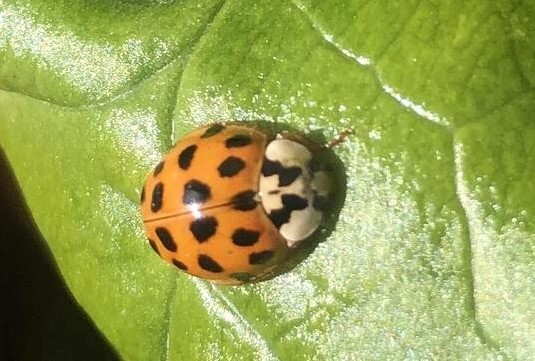Ladybugs everywhere: Managing multicolored Asian lady beetles

JACKSONVILLE, Ill. — As the days get shorter and the temperatures get cooler, many species of insects will search for places to spend the winter. Depending on the insect, they will seek out a variety of locations, such as in soil, under leaf litter, under tree bark, or even in our homes. One that we commonly encounter trying to enter homes is the multicolored Asian lady beetle (Harmonia axyridis).
Identifying multicolored Asian lady beetles
Multicolored Asian lady beetles are generally larger than native lady beetle species, about ¼ inch long. As their name implies, the beetles can vary in color, which can range from yellowish-orange to red or even black. The beetles can have anywhere from zero to 19 spots. One characteristic often used to identify them is the presence of an M-shaped pattern on the pronotum. However, this pattern isn’t always present.
Why do they come to homes?
Multicolored Asian lady beetles can be a nuisance as aggregate on and make their way into homes and other buildings in search of somewhere to overwinter. They will begin to look for places to overwinter during warm days (at least the 60s) after the first frost (or near-freezing temperatures).
They are attracted to prominent isolated objects, which in many areas are homes. They also tend to prefer white or light-colored objects, so if you have a white house and your neighbor’s is brown, there’s a good chance you’ll be seeing more beetles on your house than theirs.
Once they find an attractive location, they will usually form aggregations on walls with western or southern exposure and will then begin to look for cracks and crevices to overwinter in.
How do I get rid of multicolored Asian lady beetles in my house?
As the saying goes, an ounce of prevention is worth a pound of cure. The best management strategy is to keep them out of your home in the first place (exclusion).
- Make sure windows and doors fit tight
- Make sure window screens don’t have any holes in them
- Seal any openings, cracks, and crevices around the foundation, pipes, wires, and chimney
- •Make sure siding, eaves, and soffits are in good condition
Once they get indoors, they can be swept up and released outdoors or placed in soapy water and disposed of. One drawback to sweeping is that when disturbed, lady beetles will release a yellow defensive chemical from their legs, known as reflex bleeding, which smells bad and can stain.
To avoid staining, lady beetles can be vacuumed, bags should be emptied to prevent beetles from escaping. If you don’t want to have to repeatedly empty your vacuum, you can stick a pantyhose inside of the hose attachment and secure it to the end with a rubber band. The beetles will be collected into the pantyhose, which can then be removed and disposed of.
Insecticides are generally not recommended to manage multicolored Asian lady beetles. Insecticides applied to the perimeter of buildings are often ineffective because the lady beetles are rather mobile, and it can be challenging to get adequate control of them.
Miss Clipping Out Stories to Save for Later?
Click the Purchase Story button below to order a print of this story. We will print it for you on matte photo paper to keep forever.

